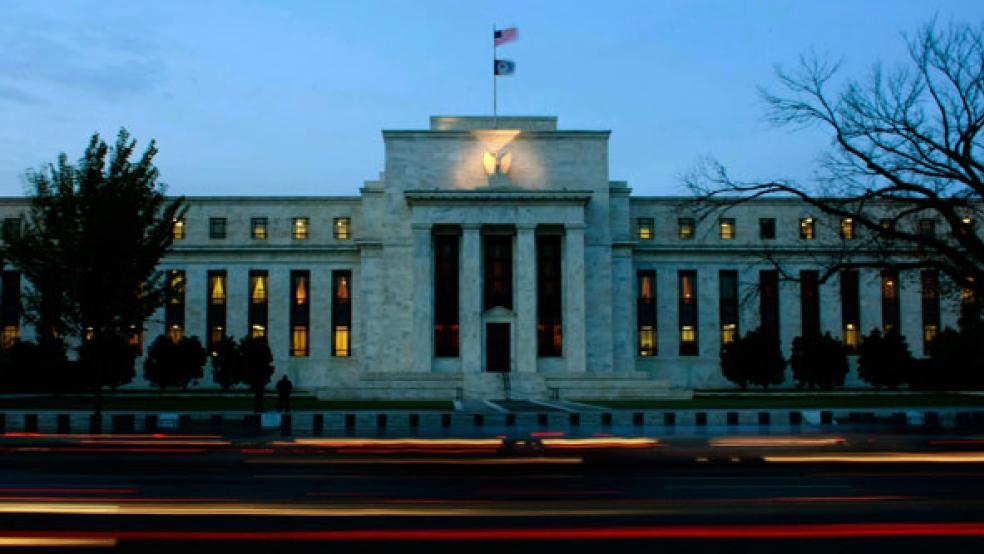A top Federal Reserve official who is sometimes seen as a bellwether for U.S. monetary policy on Monday offered his voice to a growing contingent at the central bank that has argued for reducing the Fed's bond buying at a meeting next week.
The remarks from St. Louis Federal Reserve Bank President James Bullard voicing support for a "small taper" were unexpected. He joined a chorus of more-hawkish officials, including two on Monday, who also want to begin trimming the central bank's $85 billion per month asset-purchase pace.
Related: Traders Game Fed Reaction to November Job Numbers
Bullard has in recent months argued against easing up on the monetary gas pedal in light of overly low inflation. But he said reducing the bond buying at the December 17-18 meeting would acknowledge the vast improvement in the job market since the program began last September, while still giving the central bank the flexibility to reverse course if inflation continues to linger too far below the Fed's 2 percent target.
Bullard said investors would probably not be caught off guard if the Fed started to wind down the purchases in the near future. "If we taper soon, I actually think financial markets should be able to digest it," he told a group of financial analysts in St. Louis. "We would be tapering in response to stronger economic data and therefore I think markets can be a lot more comfortable with that."
Two other top officials who are long-time opponents of the bond-buying program - Richmond Federal Reserve Bank President Jeffrey Lacker and Dallas Fed chief Richard Fisher - on Monday both said the risks of continued super-easy monetary policy exceed the benefits.
The Kansas City Fed's Esther George has been dissenting against the program all year, while fellow hawk Charles Plosser of the Philadelphia Fed said on Friday: "The sooner we can end this thing the better." But the central bank's leadership has not shown its hand, and while a few economists now believe the Fed could start trimming purchases next week, most still think the Fed will wait until January or March to make sure recent signs of strength in the labor market are lasting.
Related: Four Questions Janet Yellen Needs to Answer
Scott Anderson, chief economist at Bank of the West in San Francisco, said Bullard's comments signaled the Fed was drawing closer to making a move, although he still expects them to wait until early next year. "Now that the doves like Bullard are starting to make these kind of comments, it suggests a taper decision is very close," he said.
The Fed has kept interest rates near zero for five years and has swelled its balance sheet to nearly $4 trillion to spur investment, hiring and growth.
Now that unemployment has dropped to 7 percent from a post-recession high of 10 percent, financial markets are on edge about when the Fed will make its first move. U.S. employers added 203,000 jobs to their payrolls last month, more than economists had expected.
"One reaction to that would be to say 'how about if we have a small taper at the upcoming meeting?' and that would recognize the progress that's been made in labor markets, which I think is undeniable," Bullard said. "Should inflation not return toward target, the committee could pause tapering at subsequent meetings."
Related: Surfing Central Banks in a Benign 'QE Trap'
Bullard also said there were few signs that easy monetary policy had inflated new bubbles in the U.S. economy. One area of concern, he said, would be the bond market, but he noted that yields on U.S. government debt have risen since the spring.
"I think some of that froth has probably come off during the summer and the autumn," he said.
Speaking in Charlotte, North Carolina, Lacker said pressing on with the Fed's bond-buying program would do little to help an economy being held back by slow growth in population and productivity. But continuing the purchases "does increase the size of our balance sheet and correspondingly increases the risks associated with the exit process when it becomes time to withdraw the stimulus," he told the Charlotte Chamber of Commerce.
Lacker has said in the past that it would be appropriate for the central bank to start winding down its 15-month-old bond-buying program sometime between December and March. He warned that any change to the program would cause markets to question the path of short-term interest rates. The Fed has said benchmark rates will remain near zero until the jobless rate falls to at least 6.5 percent.
"We need to take very good care that we're clear and market expectations are aligned with us on the path of short-term rates," Lacker said, adding he would be "wary of moving those thresholds around with great frequency."
Some economists expect the Fed to lower that jobless rate threshold as a way to convince markets short-term rates are going to stay low even as the bond buying draws to a close.




